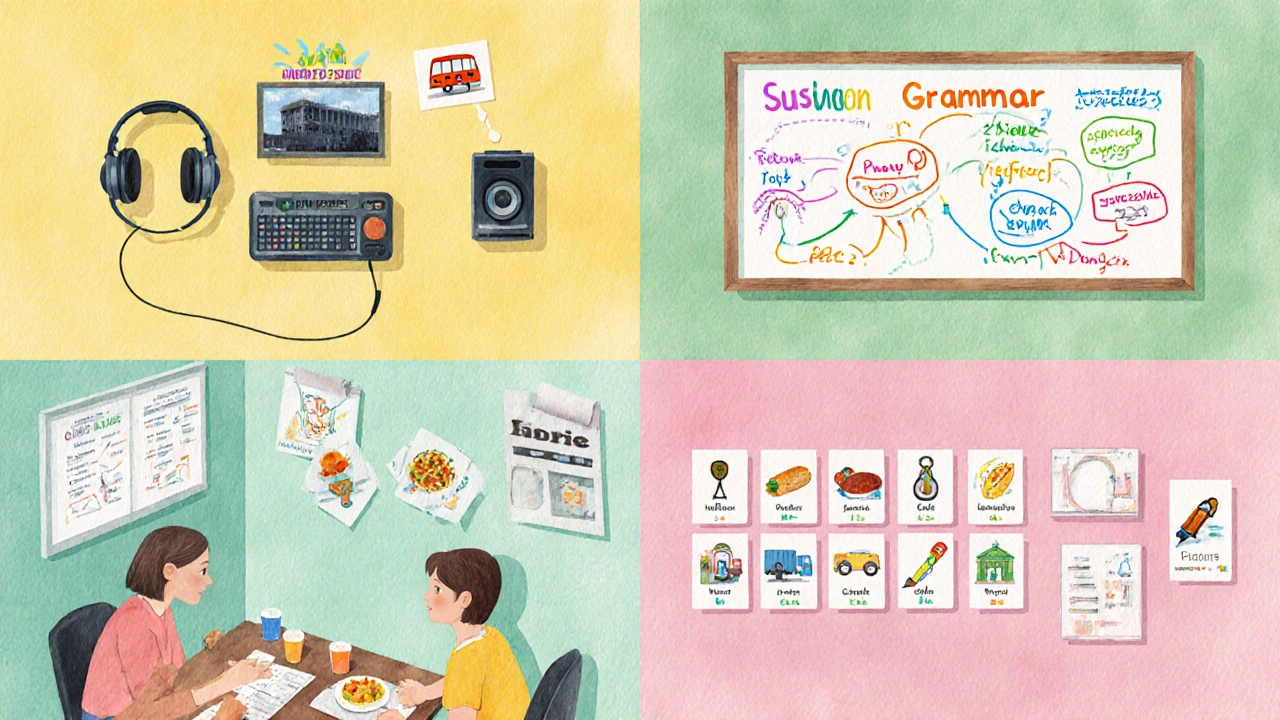English Course Format Selector
Find Your Ideal English Course Format
Answer a few questions about your learning preferences, and we'll recommend which course format best matches your needs.
In-Person
Face-to-face interaction, immediate feedback, structured schedule
Best for: Those who thrive on personal interaction
Cost: $300-$600
Live Online
Real-time video, breakout rooms, can record sessions
Best for: Those who need structure but cannot commute
Cost: $200-$450
Self-Paced
Anytime, anywhere access, forum-based interaction
Best for: Self-motivated students with tight budgets
Cost: $100-$250
Millions of people type “what is a basic English course?” into a search box, hoping to find a simple answer that tells them if the investment is worth their time. The truth is, a basic English course isn’t a one‑size‑fits‑all product-it’s a carefully structured learning path that takes a non‑native speaker from zero or very low proficiency to a level where everyday conversation becomes manageable.
Defining the Basic English Course
Basic English Course is a beginner‑level program that introduces core language skills-listening, speaking, reading, writing, grammar and vocabulary-to learners who have little or no prior exposure to English. It typically aligns with the lowest rung of the Common European Framework of Reference for Languages, known as CEFR A1, and it aims to build confidence for real‑world communication.
Who Benefits From a Basic English Course?
Most participants fall into the English as a Second Language (ESL) category of learners who need English for daily life, work, study or immigration umbrella. Common profiles include:
- New immigrants arriving in an English‑speaking country and needing to navigate services, schools and workplaces.
- International students preparing for higher‑education programs where English is the medium of instruction.
- Tourists or expatriates who want to survive everyday situations-ordering food, asking for directions, making small talk.
- Employers who want to upskill junior staff for customer‑facing roles.
Even native‑language speakers sometimes enroll to refresh forgotten basics or to prepare for certification exams like the TOEFL ITP.
Core Components of a Basic English Course
A well‑designed program breaks down the language into bite‑size building blocks. The main pillars are:
- Speaking skills focus on pronunciation, intonation and basic conversational structures.
- Listening skills train learners to understand common phrases, simple questions and everyday audio cues.
- Grammar fundamentals cover sentence order, verb to‑be, simple present tense, articles and basic prepositions.
- Vocabulary building introduces high‑frequency words for topics like food, travel, work and family.
- Reading and writing at the sentence level, often using short dialogues, notices, emails and simple forms.
All these elements are tied to the CEFR A1 benchmark that describes the ability to understand and use familiar everyday expressions and very basic phrases standards. By the end of the course, learners should be able to introduce themselves, ask simple questions, fill out basic paperwork and follow short spoken instructions.
Typical Curriculum Layout
Most providers schedule the curriculum over 8 to 12 weeks, with two to three contact hours per week. A sample week might look like this:
- Warm‑up (10 min): Quick vocabulary flashcards using visual prompts.
- Listening activity (20 min): Short audio clip (e.g., a bus announcement) followed by comprehension questions.
- Grammar focus (30 min): Introduction of a rule (e.g., “subject + verb + object”), guided practice, then pair drills.
- Speaking practice (30 min): Role‑plays such as ordering food or asking for directions.
- Reading & writing (20 min): Simple email exchange or filling out a travel form.
- Review & homework (10 min): Recap key points and assign a short listening or vocabulary task.
Assessment is usually formative-short quizzes, oral checks, and a final practical test that mirrors everyday situations.
Delivery Formats: In‑Person, Live Online, and Self‑Paced
How you attend the course matters as much as what you learn. The three major delivery models each have pros and cons.
| Aspect | In‑Person Classroom | Live Online (Zoom, Teams) | Self‑Paced Platform |
|---|---|---|---|
| Interaction | Face‑to‑face, immediate feedback | Real‑time video, breakout rooms | Forum‑based, delayed feedback |
| Flexibility | Fixed schedule, commuting required | Scheduled live sessions, can record | Anytime, anywhere |
| Typical Cost (USD) | $300‑$600 per 12‑week block | $200‑$450 | $100‑$250 |
| Best for | Learners who thrive on personal interaction | Those who need structure but cannot commute | Self‑motivated students with tight budgets |
Popular Online learning platforms such as Coursera, Udemy and Duolingo that host beginner English tracks usually fall into the self‑paced category. They often bundle video lessons, interactive quizzes, and AI‑driven pronunciation checks.
Traditional Classroom instruction offered by community colleges, language schools and multicultural centers brings the advantage of immediate correction and peer interaction, which is especially helpful for speaking confidence.
Immersion programs-short‑term stays in an English‑speaking environment where all daily activities are conducted in English-are another route, but they are usually more intensive and pricier than a standard basic course.

Benefits Beyond the Classroom
Finishing a basic English course unlocks several real‑world perks:
- Improved employability: Many entry‑level jobs list “basic English communication” as a requirement.
- Easier navigation of public services: filling out forms, medical appointments, and rental agreements become less stressful.
- Greater social confidence: you can join community events, make small talk, and build friendships.
- Foundation for higher‑level study: the A1 level paves the way for intermediate (B1) courses, IELTS preparation, or university English for Academic Purposes.
Choosing the Right Basic English Course - A Quick Checklist
- Check the alignment with CEFR A1. Reputable providers explicitly state the target level.
- Identify the delivery mode that matches your schedule and learning style (in‑person, live online, or self‑paced).
- Look for qualified instructors-ideally native speakers with TESOL or CELTA certification.
- Review the syllabus: does it cover speaking, listening, grammar, and vocabulary in a balanced way?
- Consider class size. Smaller groups (5‑8 learners) usually mean more speaking time.
- Ask about assessment methods. Continuous feedback is more useful than a single final test.
- Evaluate cost versus included resources (textbooks, online portals, extra tutoring).
- Read recent student reviews or ask for a trial lesson.
Following this checklist narrows the field quickly and helps you avoid hidden fees or courses that skim the basics.
Common Pitfalls and How to Avoid Them
Even with a solid curriculum, learners can hit roadblocks. Here are the most frequent issues and practical fixes:
- Skipping the listening component. Many think “I can read, so I’ll ignore audio.” Counter this by setting a daily 5‑minute listening habit-podcasts for beginners, YouTube captions, or the platform’s built‑in recordings.
- Relying solely on memorization. Grammar drills without context lead to robotic speech. Pair each rule with a role‑play that mirrors a real scenario.
- Neglecting pronunciation. Learners often avoid sounding “wrong.” Use the AI pronunciation check on platforms like Duolingo or ask your instructor for quick corrective feedback.
- Skipping homework. Practice solidifies neural pathways. Treat each assignment as a short‑term mission rather than a chore.
- Choosing a course that’s too advanced. Jumping to B1 level before mastering A1 can cause frustration. Verify the course’s entry requirements before enrolling.
Next Steps After Completing a Basic English Course
Reaching the A1 milestone is just the beginning. To keep momentum:
- Enroll in a B1 (intermediate) course that introduces complex tenses and expanded vocabulary.
- Join a conversation club or language‑exchange meet‑up to practice speaking in a low‑pressure environment.
- Start consuming simple English media-children’s books, beginner podcasts, or subtitles on popular shows.
- Set a concrete goal, such as passing the TOEFL ITP at a beginner‑friendly score, to give your study a clear direction.
Remember, language learning is cumulative. The habits you form now will pay off for years to come.

What level does a basic English course cover?
Most beginner programs target the CEFR A1 level, which means learners can understand and use everyday expressions, introduce themselves, and ask simple questions.
How long does it usually take to finish?
Typical durations range from 8 to 12 weeks, with two to three contact hours each week. Self‑paced courses can extend the timeline based on individual study habits.
Do I need a computer for an online basic English course?
A stable internet connection and a device with a microphone are enough for live‑online classes. Self‑paced platforms work on smartphones, tablets or computers.
Is certification available after completing a basic course?
Many schools issue a completion certificate that states the learner has reached CEFR A1. Some also offer the TOEFL ITP as a formal test for academic or professional purposes.
Can I switch from an in‑person to an online format later?
Most providers allow a transition, but you may need to transfer credits or re‑register for the new format. Check the enrollment policy before you start.
